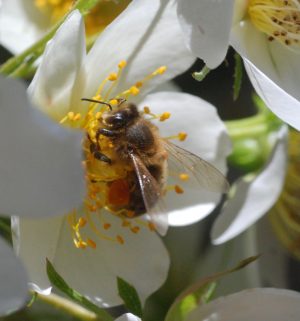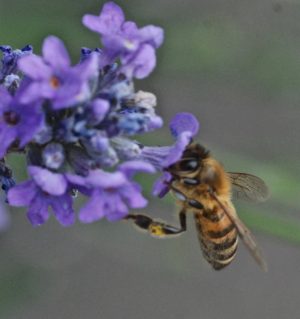Bees and the landscape

Bumblebees and honeybees seem to be assailed from all sides - pesticides, parasites and viruses, habitat fragmentation, climate change all come into play. Now a study of honeybees in the North West (of the UK) suggests that there is a clear link between their immediate landscape and the quality of their diet.
Bees collect pollen and nectar for their food Nectar is converted into honey in the hive, whilst the pollen is converted into beebread / 'bee pollen' . The beebread is the main food source for honey bee larvae and workers, indeed it is the primary source of protein for the hive But like honey, the exact chemical composition depends on the plants the worker bees gather the pollen from This can vary from hour to hour, day to day with no two samples of bee pollen exactly identical In consequence, the protein levels in beebread vary because not all pollen is ‘equal’ The pollen from some species can have relatively high levels of protein, whereas others have quite low protein values.
Work by the Environment Centre at Lancaster University has shown that the protein content of beebread is strongly correlated with the nature of the land use around the honeybee hives.  The centre analysed material from 35 hives at 20 different sites across NW England. The protein content was found to be lower when arable and horticultural farmland surrounded the hives Hives situated in natural grassland or in broadleaf woodlands had higher protein levels The protein content is critical as it is known that if larvae are exposed to lower levels of protein intake - their life span and their immune responses can be reduced.
The centre analysed material from 35 hives at 20 different sites across NW England. The protein content was found to be lower when arable and horticultural farmland surrounded the hives Hives situated in natural grassland or in broadleaf woodlands had higher protein levels The protein content is critical as it is known that if larvae are exposed to lower levels of protein intake - their life span and their immune responses can be reduced.
With increasing mechanisation and the move to bigger farms, our landscape has changed to accommodate farming practices - such as, the cultivation of large fields of single crop species Consequently, honeybee colonies used for pollination services have little or no choice of food and limited access to natural vegetation Whilst crops like oilseed rape may provide vast expanses of pollen and nectar when they are in flower, little is known about their floral resources in terms of bee nutrition. It seems probable that species such as honeybees may need to forage for pollen and nectar from a variety of plants to obtain adequate nutrition, the above research would seem to suggest that this is indeed the case.
Comments are closed for this post.
Discussion
Bees require different sugars at different times and for different purposes, from a variety of plant sources- this was scientifically years ago: The Pollination of Flowers (1973) by Michael Proctor and Peter Yeo Publishers, Collins- The New Naturalist Series.
Very interesting research and yet more evidence re the problems facing our bees as a result of drastic changes to the landscape.

Although both honey bee and bumble bee colonies are suffering, are they both susceptible to the same diseases and symptoms? It seems that we are uncovering more mess of our own making, in an inexorable spiral
don johnston
2 November, 2018